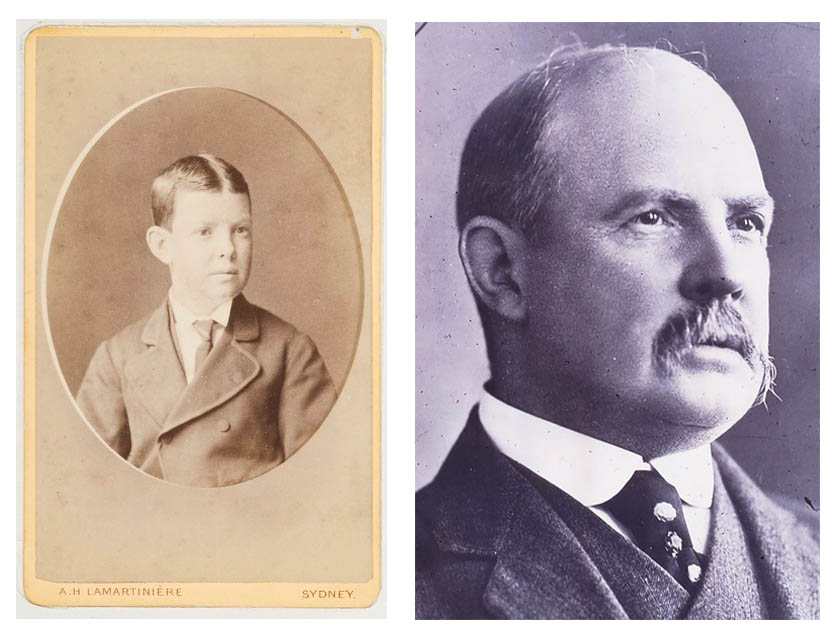
Who was Percy Allan?
Rugby player and bridge designer
Fortunate beginnings
Percy Allan was born on 12 July 1861 in Sydney and was Educated at Calder House in Sydney[44]. He joined the Roads Branch, Department of Public Works, as a cadet in 1878. Percy was to note at his retirement speech that he “joined the (public) service because I thought it my duty when my family had been doing the same thing (for so long)”.[45] With patronage still a leading factor in public service preferment, Allan’s new post owed something to his father’s position as Principal Under-Secretary of the Colonial Secretary’s department. Maxwell Rennie Allan’s career closed with his death only months later in 1879. Percy Allan’s grandfather, David Allan, had arrived in Australia in 1808 and was Deputy Commissary-General from 1818 to 1823.[46]
 Source: SNNSW Graphic Materials P1 / 27 (left), The Sydney Morning Herald, Thursday 8 May 1930, p 12 (right)
Source: SNNSW Graphic Materials P1 / 27 (left), The Sydney Morning Herald, Thursday 8 May 1930, p 12 (right) Percy Allan became Assistant Draftsman in 1882 and Chief Draftsman in 1889. His training by pupillage continued under senior engineers within the department in accordance with the conditions prescribed by the Institution of Civil Engineers, London, although some of his contemporaries were pioneers in academic schools of engineering[47]. In 1893, upon the retrenchment of McDonald, Allan introduced significant changes to timber beam and timber truss bridge design, including the development of what is now known as the Allan truss.[48]
An extraordinary team
By this time, he had worked with Bennett for over ten years and with McDonald for almost 15 years. He had worked briefly with Professor Warren and had had the benefit of de Burgh’s assistance for eight years and Dare’s for four years. A timeline showing the periods of construction of the different truss types and the periods of employment of the different design engineers is provided below. Allan was able to make progress in the design of timber truss bridges because he had access to information regarding the structural properties of Australian hardwoods and 35 years of historical data on various timber designs. He also had access to a team of exceptional young engineers to assist in design development.
Appointed Assistant Engineer for Bridges in 1895, he was promoted a year later to engineer-in-charge of bridge design. In 1900 Allan assumed increased responsibility for rivers, artesian bores, water-supply and drainage. His work included supervising the construction of Sydney's sewerage system with ocean outfalls. In Newcastle from 1908 until 1912 as District then Chief Engineer, among other things, he designed and built additional coal-loading wharves and cranes. From 1917 until he retired in 1927, he was Chief Engineer, National and Local Government Works.[49]
Percy Allan was the first president and a life member of the Northern Engineering Institute and of its successor, the Newcastle division of the Institution of Engineers, Australia. He was also a member of the American Society of Civil Engineers. He had a distinguished career, and left many monuments, having designed nearly six hundred bridges. Dr J.J.C. Bradfield (designer of the Sydney Harbour Bridge) said that whatever success he had attained he owed largely to the assistance he had received from Allan in his youth.[50] Allan was awarded a Telford Premium in 1921 by the Institution of Civil Engineers (London), for a paper submitted on the port improvements at Newcastle. The Telford Premiums were monetary awards for papers considered worthy, and, according to the newspapers of the day, were highly regarded.[51]
In addition to designing timber truss bridges, Percy Allan designed the very innovative swing spans for the Pyrmont Bridge and the old Glebe Island Bridge. The fact that Pyrmont Bridge was Australian designed and Australian built was a focal point for national pride at the time of federation.[52] Percy Allan also designed a number of lift spans some of which were even noticed overseas, such as the ones at Swan Hill, Tooleybuc and Dunmore, and a number of steel truss bridges, including Tom Uglys Bridge over the Georges River in southern Sydney.[53]
Family life
As a member of the Newtown Football Club he toured New Zealand in the 1886 Rugby side and later was a referee (“Percy Allan” Australian Dictionary of Biography online). Allan married Alice Mary Trangmar at the Roman Catholic Church, Hawthorn, Melbourne, on 11 November 1890. He and his wife were keen golfers and regularly played in mixed foursomes at the Botany links of the Australian Golf Club (“Golf Australian G.C”. 9 January 1907, SMH, p.7). His three sons were all prominent first grade footballers and all joined the Australian Imperial Forces at the onset on the First World War. His eldest son Myrton Trangmar Allan qualified as a solicitor before the war and became a lieutenant with the 6th Australian Field Ambulance but was killed in France in 1916. His other sons Herbert and Keith survived the war and Herbert went on to complete his legal studies. Seeking a more adventurous life, he went to the Territory of New Guinea and worked as a goldminer and plantation overseer. When hostilities broke out again he fought in Tobruk for which he was awarded an O.B.E. and eventually retired with the rank of honorary Colonel (Herbert Trangmar Allan (1895-1967, ADB online).
Allan died suddenly of angina and cardiac failure at his residence, Carnarvon, Darlinghurst at the age of 68 on 7 May 1930. He had been living in retirement for more than two years. He was survived by his wife and two sons and was buried at South Head Cemetery, Row 1, Section N, plot number 37. One cannot help but feel he drove himself hard to succeed both to prove himself to his father who was known as “an extremely valued public officer” and also to strike a note for native-born Australians in a field dominated by British and Irish engineers (“Obituary Maxwell Rennie Allan”, Sydney Mail, April 12, 1879, p.19).
References
[44]Ashworth P. Burke, History of the Colonial Gentry, London: Harrison and Sons, 1895 p xxii.
[45]Mr Percy Allan Colleagues farewell, SMH, 5 May 1926, p.12
[46]‘Mr. Percy Allan. Noted Engineer’s Death’, The Sydney Morning Herald, Thursday 8 May 1930, p 12.
[47]Arthur Corbett, 'Allan, Percy (1861–1930)', Australian Dictionary of Biography, National Centre of Biography, Australian National University, http://adb.anu.edu.au/biography/allan-percy-4996/text8303, published first in hardcopy 1979, accessed online 23 June 2017.
[48]Annual Report of the Department of Public Works to the Legislative Assembly 1894, p 123.
[49]Arthur Corbett, 'Allan, Percy (1861–1930)', Australian Dictionary of Biography.
[50]“Mr Percy Allan, Colleagues’ Farewell”, Sydney Morning Herald, Friday 5 March 1926, p 12.
[51]“Sydney Engineers Honoured, The Telford Premiums”, SMH, Wednesday 4 May 1921, p 10.
[52]Engineers Australia, Proposal to landmark the Pyrmont Bridge, National Engineering Landmark, 1991, p 5.
[53]H.G. Tyrrell, Evolution of Vertical Lift Bridges, Toronto: University of Toronto Engineering Soc., 1912 p 12.




